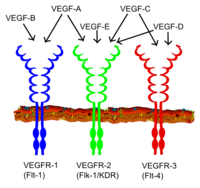
Photo from wikipedia
First discovered in the 1984, the MET receptor tyrosine kinase (RTK) and its ligand hepatocyte growth factor or HGF (also known as scatter factor or SF) are implicated as key… Click to show full abstract
First discovered in the 1984, the MET receptor tyrosine kinase (RTK) and its ligand hepatocyte growth factor or HGF (also known as scatter factor or SF) are implicated as key players in tumor cell migration, proliferation, and invasion in a variety of cancers. This pathway also plays a key role during embryogenesis in the development of muscular and nervous structures. High expression of the MET receptor has been shown to correlate with poor prognosis and resistance to therapy. MET exon 14 splicing variants, initially identified by us in lung cancer, is actionable through various tyrosine kinase inhibitors (TKIs). For this reason, this pathway is of interest as a therapeutic target. In this chapter we will be discussing the history of MET, the genetics of this RTK, and give some background on the receptor biology. Furthermore, we will discuss directed therapeutics, mechanisms of resistance, and the future of MET as a therapeutic target.
Journal Title: Advances in cancer research
Year Published: 2020
Link to full text (if available)
Share on Social Media: Sign Up to like & get
recommendations!